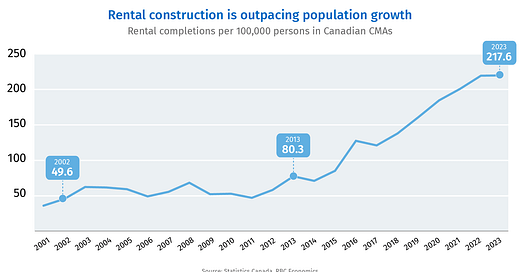1. Why it's time for a serious debate about rent control in Canada
Ricardo Tranjan, National Post, November 25, 2024
The third fact is that rent controls benefit tenants and businesses.
Employers have historically disliked high rents as they put upward pressure on wages. High rents also force workers to live further away from work, increasing commutes, lowering job satisfaction and productivity.
2. Proof Point: Are falling rents in Canada a temporary relief or a new trend?
RBC Thought Leadership, November 27, 2024
The full impact of the federal government’s new immigration policy is yet to be seen, but Canada’s population growth rate is expected to shrink substantially in the years ahead—slowing the number of households formed by an estimated 400,000 (-46%) over the next three years.
[…]
Rent demand pressures are softening among some groups, but lower rent and easing competition could also be the catalyst attracting others to the market. This, alongside the chronic undersupply of rental housing, should contain any rent declines as the market searches for a new equilibrium. [emphasis added]
3. Killam reports 'largest rental gains' on new leases in company's history in most recent update
Like other landlords, Killam boosts rents to the market rate when new tenants sign a lease, pushing the reported average rent increase above Nova Scotia's five per cent cap. The cap only applies to lease renewals.
Killam's financial results are an example of the overall trends we've been seeing in recent years in rental markets where there's been inadequate housing supply, said Neil Lovitt, a vice-president with Turner Drake, a real estate consulting company.
"That creates an opportunity for for-profit housing providers to raise rents to market prices when they have an opportunity to do so," Lovitt said. "They're … doing what any market participant really can do."
4. Study of 2023 Okanagan wildfires recommends limiting development in high-risk areas
The case study found that embers and not direct contact with advancing flames were "almost exclusively" responsible for helping wildfires move into neighbourhoods.
[…]
The study's recommendations included limiting development, increasing zoning bylaw setbacks for structures in heavily forested areas, and improving landscaping and fencing regulations to "establish non-combustible zones around structures."
"Directing new urban development, be it residential, commercial, or industrial, towards existing urban centres and community hubs can reduce urban sprawl and minimize the creation of isolated, vulnerable developments in rural areas," the report says.
5. The cause of Colorado's most destructive wildfire ever revealed
Embers from a smoldering scrap wood fire set days earlier outside a home used by a Christian religious communal group along with a sparking power line caused a 2021 Colorado wildfire fanned by high winds that destroyed nearly 1,100 homes and left two people dead, authorities said Thursday.
[…]
Experts say similar events will become more common as climate change warms the planet and suburbs grow in fire-prone areas.



